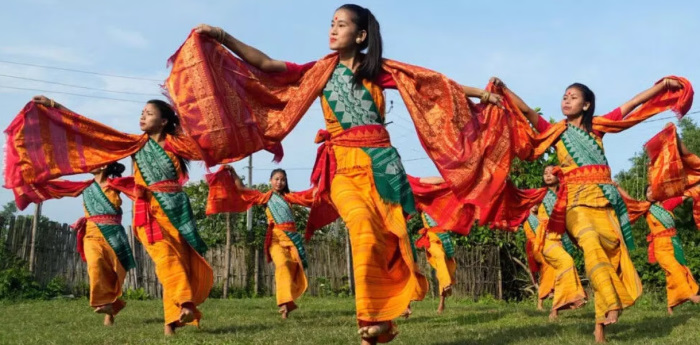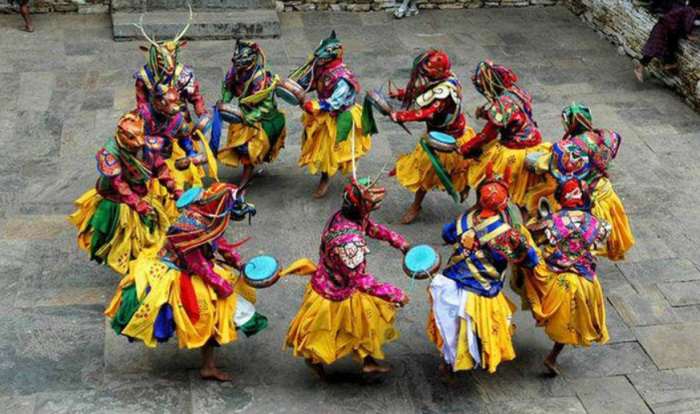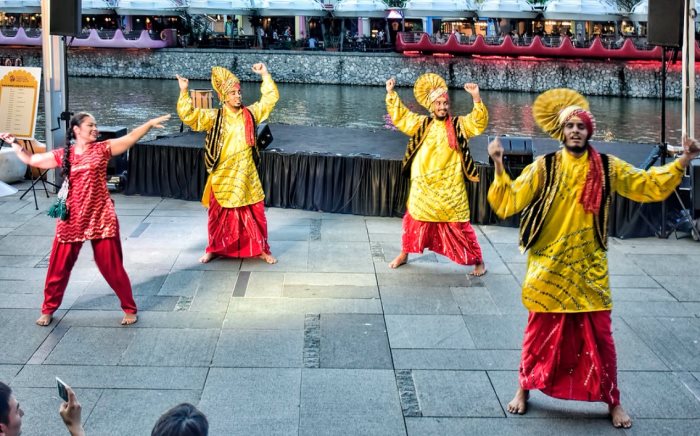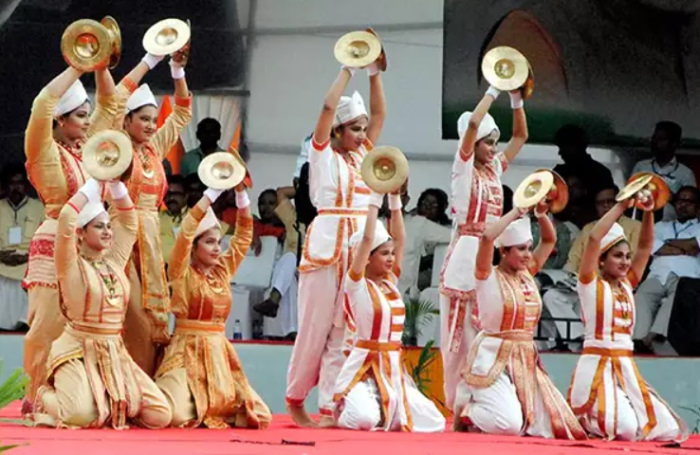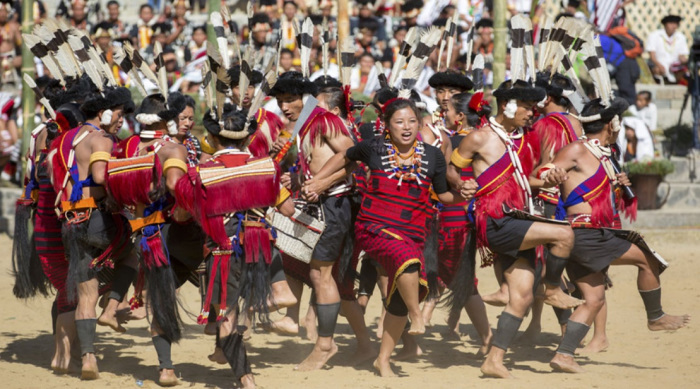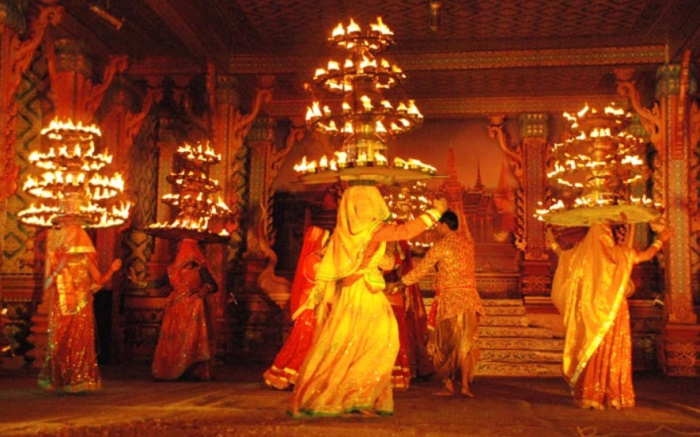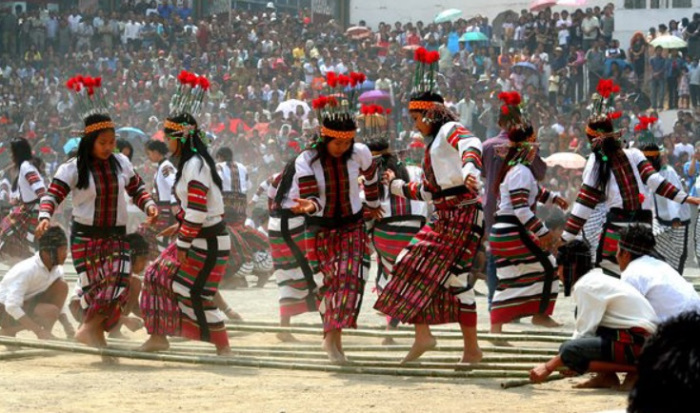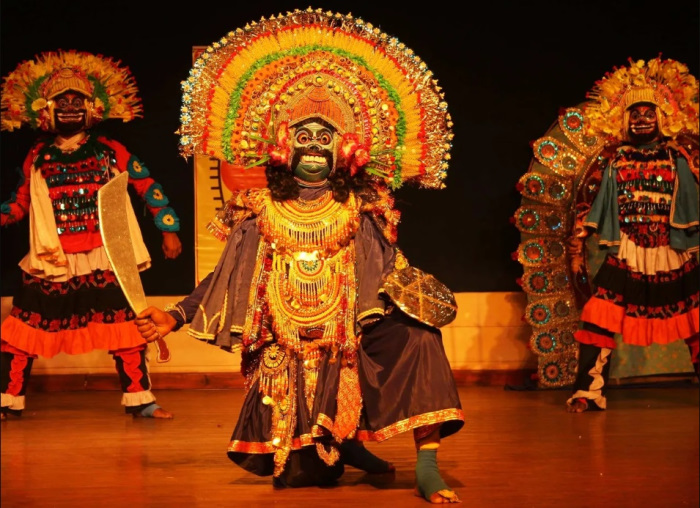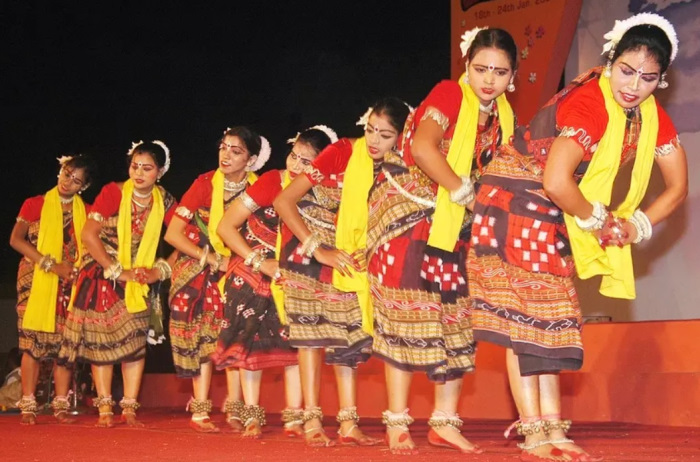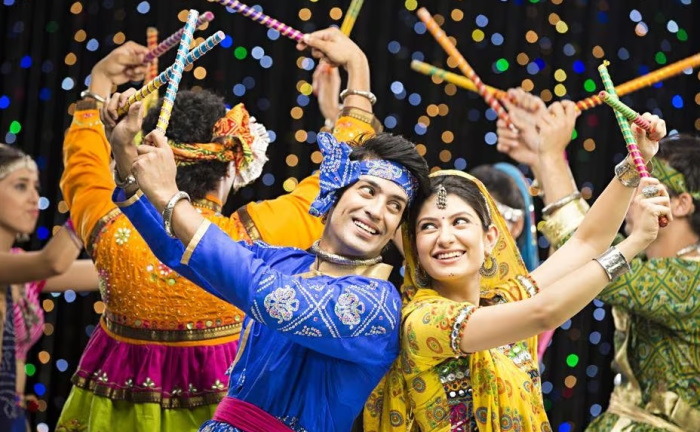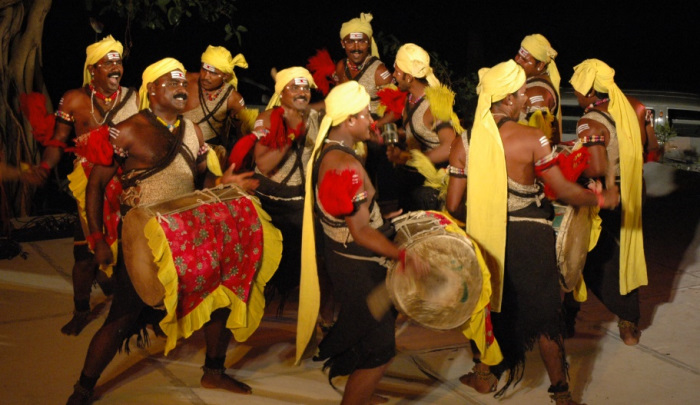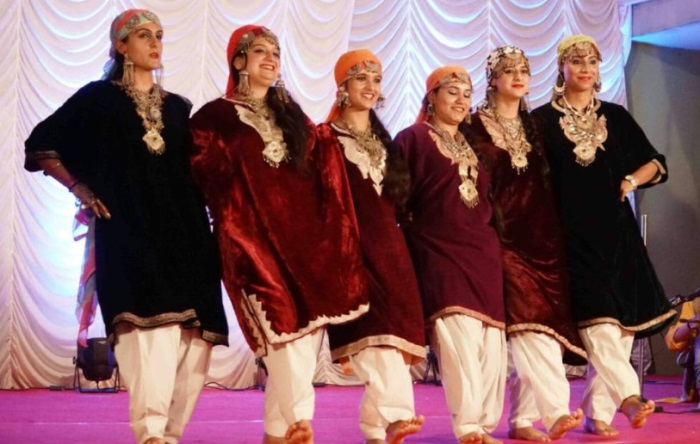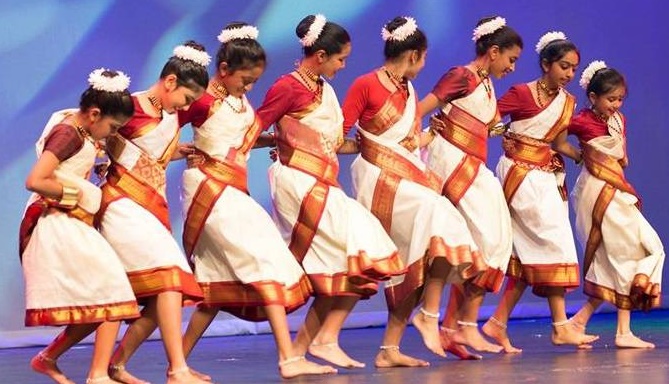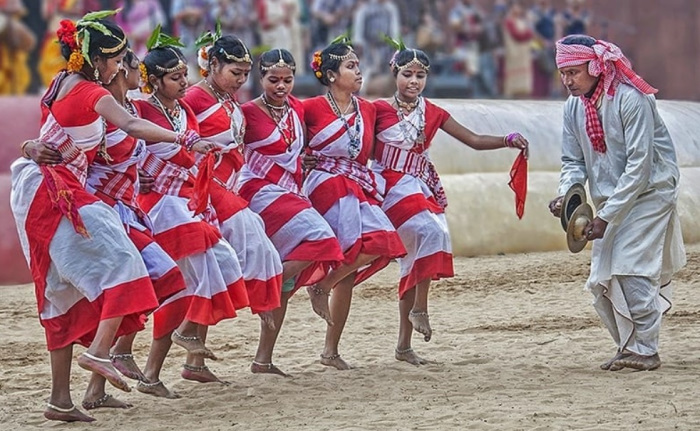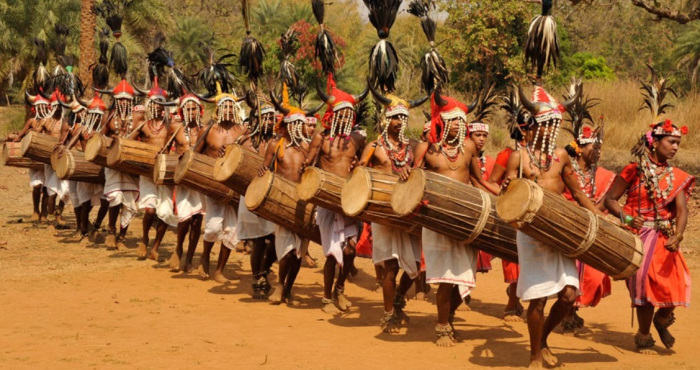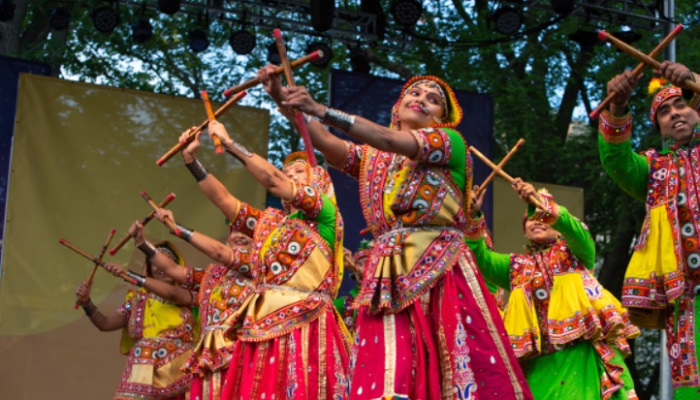The Indian culture is one of the oldest civilizations that has graced the earth. Hence, it is no surprise that they have countless Indian folk dances to preserve their traditions through numerous centuries.
Let’s do a quick head count and amaze ourselves!
Table of Contents
- 50+ Traditional Indian Folk Dances To Identify Its Rich Culture
- Bagurumba
- Bardo Chham
- Bhagoria Dance
- Bhangra
- Bhortal Dance
- Bihu
- Brita Dance
- Chang Lo
- Charkula
- Cheraw Dance – The oldest Indian folk dances
- Chhau
- Chholiya
- Dalkhai
- Dandiya
- Dhamyal
- Dollu Kunitha
- Dumhal
- Fugdi
- Jawara Dance
- Jhumar
- Jhumur
- Gaur Dance
- Garba
- Ghodemodni
- Giddha
- Gotipua
- Grida Dance
- Hikat
- Hojagiri
- Hurka Baul
- Kaksar Dance
- Karagattam
- Karma Dance
- Kolannalu
- Koli
- Kummi
- Lava Dance
- Mayil Attam
- Mayur Nritya
- Muria Dance
- Nongkrem Dance
- Paampu Attam
- Padayani
- Padhar Dance
- Parai Attam
- Poikkaal Kuthirai Attam
- Rasa Lila
- Saila Dance
- Suwa Dance
- Tertali Dance
- Theyyam
- Tippani Dance
- Veeragase
- Indian Folk Dances of State-wise Distribution
- Final Words
50+ Traditional Indian Folk Dances To Identify Its Rich Culture
Bagurumba
Known as the most attractive dance of the Assam state and said to inspire nature, Bagurumba is full of joy and spirit.
It is performed by Bodo women dressed in the most colorful and beautiful traditional costumes with Bodo’s special instruments accompanying.
As the dance includes quick swinging and hopping, the dancers end up portraying a resemblance to butterflies, which contributes to their second name the “butterfly dance”.
Check more: 15 Best Indian Dancers From Classical To Modern Dance
Bardo Chham
Mostly seen in the Sherdukpens tribe of Arunachal Pradesh, Bardo Chham means “The Dance of the Zodiacs”.
The people here believe each zodiac comes with an evil spirit, and humankind must find a way to defeat them.
The dance depicts their belief that good will prevail eventually.
Both men and women can join this dance.
They will adorn costumes with bright colors and wear elaborate headpieces as symbolization of the evils we must eliminate.
The eye-catching outfit is undoubtedly a bonus point for Bardo Chham.
Bhagoria Dance
Bhagoria is the traditional dance associated with a festival and a fair of the same name.
Originally, it was a ritual to pray for fertility, though its essence gradually changed with time.
Nowadays, we mostly know of it as an exhilarating performance where young men and women dance with the person they like.
The outfit is rather simple but don’t forget that male dancers need to hold a bow. For the ladies, the props are a handkerchief and a mirror.
In the background, there are musicians and singers forming an arc circling the dance team.
Bhangra
Although there is no specific information about the origin of Bhangra, we can only confirm it comes from Punjab.
Some people claim Bhangra is related to martial arts, yet others believe the farmers created it for their harvest celebration.
A proper performance of Bhangra involves kicks, bends, and leaps at a quick and vigorous pace – hence it can be physically demanding, especially for women.
However, young Punjabi ladies are actively practicing Bhangra nowadays as a way to resonate with their culture.
Bhortal Dance
Acclaimed as one of the most enthusiastic folk dances of India’s Assam, Bhortal is undoubtedly people’s ultimate favorite.
The zealousness is enhanced by the drum beats by the band and the cymbals used by the dancers.
There is no limit to how many people can join the fun but they will be divided into groups of 6 – 7 members. Rapid movements and interesting props surely make the celebration worthwhile.
Bihu
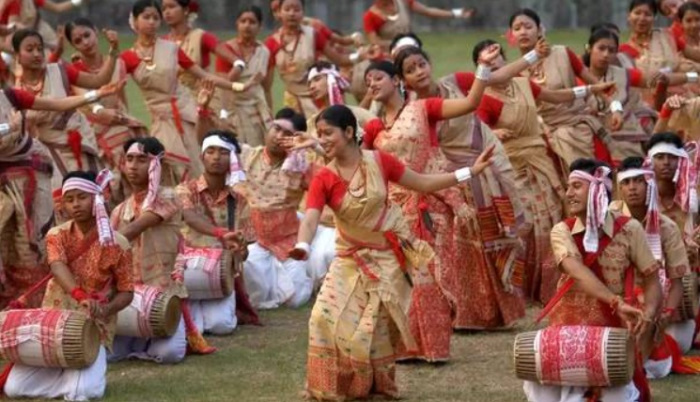
While we don’t know how the Bihu dance came to life, we can be sure of how significant it is in the Assamese culture nowadays.
Scholars state that Bihu is a dance symbolizing fertility and prosperity, explaining the happiness radiating from it.
The dance is executed by both men and women adorning red-themed clothes.
To start the performance, the men will step into their positions and play traditional instruments such as drums, flutes, and pipes.
Meanwhile, women dance to the rhythm with quick steps and brisk hand motions.
Brita Dance
Among the dances of West Bengal, Brita holds a special position for the folks since it is considered a prayer.
People here perform the Brita dance to ask for holy blessings or to show gratitude toward the deities after recovering from diseases.
Brita performers wear white sarees with purple seams, bangles, and necklaces. This elaborate outfit increases the difficulty of complex hand and foot gestures.
Chang Lo
Chang Lo belongs to the special types of Indian folk dances, for it was a celebration performance of the Nagaland’s Chang tribe when their soldiers defeated an enemy troupe.
We temporarily say goodbye to the beautiful Indian dresses and put on warrior costumes, matching the artistically modified and adjusted war tactics.
Charkula
Like other folk dances, Charkula owns several stories about its origin.
One of them refers to the birth of Radha and points toward auspicious occasions. Another relates the dance to a deity protecting people from the heavy rain.
Charkula includes female dancers in long dresses and veils.
The movements have certain restrictions due to the multi-tiered pyramid they carry with their heads as props, though it doesn’t stop the dancers from doing challenging tricks like pirouetting or bending.
Cheraw Dance – The oldest Indian folk dances
Originating from the 1st century, Cheraw is one of the oldest Indian folk dances.
Researchers say it was a ritual of solace for mothers who passed away after giving birth to their child, though it eventually became an indispensable performance in every event at the Mizoram state.
In Cheraw, we have 6 – 8 men holding a pair of bamboo staves each and clapping them together. Meanwhile, the ladies cleverly move between the staves and maintain a cheerful expression.
Chhau
Also written as Chhou, Chhau is partially an Indian classical dance with folk and martial materials. Thus, it can be arranged and performed in one or both of these styles.
Besides dancing, making the masks for the dance is also a crucial part of the Chhau culture. There are various adaptations of Chhau across the region, ranging from entertainment purposes to religious rituals.
Chholiya
Chholiya is commonly known as the sword dance, performed in wedding ceremonies back when marriages took place in the presence and blessings of swords.
As time goes by, the meaning of Chholiya has expanded tremendously, making it an important part of any auspicious event.
Dalkhai
The name Radha appears once again, this time in a love story with Krishna, and the Dalkhai dance is a depiction of their romance. The name comes from the phrase “Dalkhai Bo!” shouted by the dancers.
Being an opportunity for men and women to flirt with the person they like, this dance comes with colorful outfits and several instruments with joyful sounds.
Dandiya
Dandiya is among the top in popularity and is also part of the great festival Navratri. It mainly symbolizes the triumphant feeling when the good rises above the evil.
The performance is for both men and women. All holding polished wooden sticks and striking the ‘Dandiya Ras’ while spinning to the joyous melody.
Therefore, it is sometimes referred to as the Stick dance.
Dhamyal
Dhamyal or Dhuph is an important dance of Haryana. The dancers can be of either gender, though the males would be the ones holding and playing the Dhuph drum.
According to experts, Dhamyal is akin to a reward for farmers who have worked hard in the fields all day long.
Dollu Kunitha
In Karnataka, there is hardly anyone who doesn’t know of Dollu Kunitha. The origins of it are associated with Lord Shiva, who is notorious for aggression.
The performer group consists of 10 -12 dancers capable of playing the corresponding drums. It demands stamina but its energy will always prevail.
Dumhal
Dumhal is a folk dance very well-known in Jammu and Kashmiri, in honor of the saint named Sufi.
All performers adorn embellished clothes and harmonize a soothing tune while executing captivating movements.
Depending on the occasion, male dancers will carry a banner or a flag with a message they wish to convey, which they will impale on the ground during the process.
Fugdi
The Maharashtra and Goa dance is a rare all-women performance, typically executed in Bhaadrapada, a festival for women to leave their duties behind and have fun.
To start with Fugdi, the ladies will gather and form a circle, voicing out invocations to the gods and simultaneously doing a fixed routine.
Everything is slow at first and the pace slowly picks up.
Jawara Dance
Next, we have another harvest dance of Madhya Pradesh.
The essence of this performance is the joy and satisfaction of farmers who deem themselves lucky for a rich season.
Jawara means ‘grain’, and it shows in the props that female dancers put on their heads.
As a result, they steal all the attention from the men because it takes amazing skills to dance vigorously without dropping the headgear.
Jhumar
Derived from the term ‘swaying’, Jhumar resembles a tender reminder for the dancer and the audience to move to the music. It can be a symbol of romance or ecstasy, depending on the choice of songs.
The performers are dressed in costumes and jewelry of bold and strong colors. One of them will sing to start the performance and gesture to the rest to clap, sing, and dance along.
Jhumur
Although the name sounds very similar to Jhumar, Jhumur is an Assamese folk dance and involves both genders in its performance. The men will be in charge of the instruments.
The spotlight is on the female dancers, who hold onto one another’s waist and move their limbs back & forth in sync. These movements can change according to the emotions they want to express.
Gaur Dance
Among the dances of Madhya Pradesh, there is probably none that surpasses Gaur in terms of joyful vibes, which might be why it is usually performed at weddings.
Female dancers wear elaborate accessories and paint tattoos on their bodies, while male dancers adorn extravagant headgear. They depict the powerful spirit of a hunt.
Garba
The name can be translated to ‘womb’, thus indicating life.
The main props for the dancers are lantern – a symbolization of a fetus in the womb – in honor of the divine femininity, ‘Durga’.
Another way to interpret Garba is that divinity is always present inside us, and we are the vessels for that energy.
Ghodemodni
When spring starts in Goa, the Shigmo festival takes place in celebration of the Maratha warriors. Therefore, it combines horse dancing and martial arts.
Besides the trademark vibrant colors usually seen in Indian folk dance costumes, Ghodemodni dancers have a faux horse head attached to the front and a sword in their hand, recreating a warrior look.
Giddha
Giddha is a harvest dance performed in the most important events of Punjabi people. It carries the vibes of a happy community with great harmony.
Another special thing about Giddha is it includes women only.
Wrapped in sparkly accessories and colorful clothes, they execute rhythmic moves and increase the pace toward the end while maintaining elegant postures.
Gotipua
You will hardly find any folk dance more unique than Gotipua.
It is performed by young boys only, though they will dress up as women and make good use of their androgynous look.
Along with embellished costumes, the routines of Gotipua are also challenging due to the heavy involvement of acrobatic arts.
Grida Dance
At Madhya Pradesh, you will easily spot a group of cheery dancers in traditional outfits, holding a handkerchief and a staff/clapper in their hands.
What is more special is the performers might come from different villages and simply gather to enjoy a fun dance.
At the end of the performance, they often promise to see one another next time.
Hikat
People in Kashmir welcome spring with the Hikat dance. Every pair of dancers will hold hands cross-armed and spin around together, accelerating as they go on.
Nowadays, there is no requirement for costumes and everyone can participate in Hikat.
Hojagiri
Hojagiri is a rather popular dance in Tripura, part of the Durga Puja fest.
It is carried out by a group of 4 – 6 dancers, all of whom are women. Meanwhile, the melodies are done by male performers.
The movements are quite tough, for the headgear limits the dancer’s motion and demands them to create alluring waves with their hips.
Hurka Baul
During the cultivation of maize and paddy fiends, people in Uttarakhand dance to Hurka Baul on fixed dates. It usually follows a preliminary ritual, performed at multiple spots and on numerous tunes.
The name means ‘The song of Hurka’, wherein ‘hurka’ is the drum used to accompany the dance.
Kaksar Dance
Kaksar is considered one of Madhya Predash’s performing arts, typically done by young girls and boys. The focus of their outfits is the horse dummy each dancer carries.
Rumors have it that Kaksar is also a chance for the youths to contemplate a life partner!
Karagattam
Deriving from the classical Indian dance Bharatham, Karagattam has a variety of movements. The dancers need to keep a small pot on top of their heads while dancing.
There is the casual version for happiness and the solemn version for religious rituals.
Karma Dance
Karma is Central India’s traditional dance, always associated with a festival of the same name and hence performed with colorful tribal clothes.
The dance was created as a worship ritual for Karma Devta, the god of fate. People believe this deity controls both bad and good fortune.
Kolannalu
Fun and energetic, Kolannalu (or kolkolannalu) is one of the most famous folk dances in the South.
The dancers will form two circles and pair up. The ones from the outer round will strike the sticks held by the inner lineup and create a rhythm that they all move according to.
Koli
Coming to life in 1961, the Koli dance is perhaps one of the youngest folk dances we have here.
It was part of the Republic Day Parade, even the Prime Minister took part in it.
In 2010, former President Barack Obama and his wife gained the dance more attention by performing it with students for the Diwali festival.
Kummi
Kummi is a derivation of ‘kommai’, which means ‘dance to clapping of hands’, for the dance originated from an era void of musical instruments.
As a result, the performance is quite simple with no dress code. Tamil women will simply form a circle and enjoy the dance.
The forms range from the easy level with hand claps to the complex routine mimicking daily activities.
Lava Dance
The Lava dance of Lakshadweep is a male-only performance. The dancers will line up before forming a circle and moving to the beats.
The attractiveness of Lava comes from the rigorous motions as well as the vibrant shades of the outfits, which pushes the energy level of the occasion to the maximum.
Mayil Attam
Mayil Attam is a dance from Tamil, mostly performed to honor Lord Subrahmanya. His dearest animal is the peacock, hence the dancers need to adorn similar outfits.
Because the costume is extremely complicated, being skilled and strong is mandatory for the performers.
Mayur Nritya
Another episode of the romance between Krishna and Radha took us to Uttar Pradesh, where the Mayur Nritya began and thrived.
It is commonly executed by a pair of dancers who dress like peacocks and recreate the dance of two lovers after their separation.
Muria Dance
Coming from the Bastar district, it is a tribal dance started with the invocation for their phallic higher-up.
People can perform either form: Hulki and Karsana. While Karsana is more about entertainment, Hulki is complex, serious, and thus more attractive to the audience.
Nongkrem Dance
In a traditional Nongkrem dance, female dancers will adorn vibrant and intricate costumes, while the male performers stick to simple, dark-colored outfits.
Nonetheless, the men still draw attraction toward themselves, thanks to passionate movements and distinguishable props.
It is closely associated with the corresponding festival, in which sacrifices and offerings play an important role.
Paampu Attam
Also known as the Snake dance, Paampu Attam is a Tamil dance for longevity and prosperity – the deeper symbolization of snakes.
It is usually the girls who perform Paampu Attam.
They have various movements to imitate the signature habits and actions of snakes, with great help from the outfits resembling snake skins.
Padayani
When you visit Kerala, you can ask anyone about Padayani and they will tell you everything you need to know. They treat the dance as a means to worship Goddess Bhadra Kali.
The unique touch of Padayani is the masks that the dancers wear while performing a combination of music, dance, paintings, satir, and theatre.
Padhar Dance
The origin is the Padhar dance in Gujarat. It is named after a community of fishermen down the Nal Sarovar banks.
The dancers will dance with small sticks in their hands and imitate the act of rowing boats while singing songs about the sea.
Parai Attam
Parai Attam is the oldest drum dance we know of in the history of India.
It is quite simple as the performers generate drum beats by themselves and dance to the sounds they create.
Poikkaal Kuthirai Attam
We have yet another folk dance from Tamil Nadu. It features a horse dummy with enough space for the dancer to fit in and perform with it.
The light materials attached to it will swing as they move and make the stage livelier than ever.
There are also wooden legs secured around the dancer’s ankle so they can recreate the noise of hooves.
Rasa Lila
As a worshipping ritual for Krishna, his devotees put this dance in a nonpareil position due to its mythological importance.
They believe Krishna himself performed Rasa Lilia with his lover Radha and friends. Therefore, it is also referred to as “The Dance of Divine Love”.
Saila Dance
Chhattisgarh has some extremely antique tribes and cultures, and the Saila dance is certainly one of a kind.
The performers are usually teenage boys with sticks as their props.
What makes Saila so fun to watch is every dancer will do their part while striking the stick held by the one next to them, and the cycle repeats.
Suwa Dance
Also coming from Chhattisgarh, Suwa or Parrot dance belongs to the symbolic category.
Dance skills are not the most important in Suwa but it still holds tremendous influence on tribal lives. It results in the costume being so beautiful and fascinating.
Tertali Dance
With its roots in the Kamar tribes, Tertali is more of a ritual than a mere dance.
The most common form includes three women in captivating dresses with small cymbals tied to certain spots on their bodies.
Sitting on the ground, they will execute small movements while keeping a pot on their heads and a short sword between their teeth.
Theyyam
Theyyam was originally a ritual to worship the ancestors before adapting cultural traits with time and turning into an actual dance with religious beliefs.
Theyyam has a main dancer who has to undergo tough conditions such as adorning heavy costumes and not eating anything after the sun has set.
They have to perform by the bonfire as well as complete several routines.
Tippani Dance
Timpani is from the Saurashtra region, performed by women only.
The ladies hold wooden sticks (about 175cm!) and slam them against the floor while folk songs play in the background.
Researchers say the laborers came up with this dance to make their work less exhausting and boring. However, it usually appears at weddings and festivals nowadays.
Veeragase
During the Hindu months of Karthika and Shravana, the Veeragase dance will constantly be performed, especially for important functions.
It used to be a male-only dance, though women have eventually become part of it.
The Jangama performs Veeragase also known as Lingadevaru or Maheshwaras. They put on red dresses and ornate headgear before executing intense and challenging movements.
Indian Folk Dances of State-wise Distribution
| State | Dance |
| Andhra Pradesh | Burrakatha, Koya, Lambadi, Veethi Natakam |
| Assam | Ankiya Nat, Bagurumba, Bhortal, Bihu, Canoe, Chongli, Jhumur, Gopal, Khel, Kirtania, Lila, Natak, Nongkrem, Ojapali, Rakhal, Tabal |
| Arunachal Pradesh | Bardo Chham |
| Bihar | Bidesia, Bhako, Jadur, Jatra, Jat-Jatni Bidpada, Jhijiya, Karma, Kathaputli, Natna, Ramkhelia, Senkela Chhau |
| Chhattisgarh | Raut Nacha |
| Goa | Dashavatar, Dekhni, Dhalo, Fugadi, Ghode, Gonph dance, Kunbi dance, Musal khel, Modni, Perni jagar, Samai nrutya, Talgadi, Tonya mel |
| Gujarat | Aagwa, Bhavai, Dangi Nritya, Dandiya, Garba, Hudo, Matukdi, Padhar dance, Siddi Dhamal, Tippani Dance |
| Haryana | Dhamal dance, Goga dance, Manjira, Naqqal, Ras Leela, Swang dance |
| Himachal Pradesh | Bhagat, Harnatra Haran (Harin), Kariyala, Nati, Ras Ihanld |
| Jammu and Kashmir | Bhand Pathar (Bhand lashna), Rouff, Vetal Dhamali |
| Karnataka | Bedara Vesha, Dasarata, Doddata-Bayalata, Dollu Kunitha, Radhna, Santa, Tala Maddle or Prasang, Veeragase, Yakshagana |
| Kerala | Chakyar koothu, Chavittu Nadakam, Duffmuttu, Kodiyattam, Margam Kali, Mudiattam, Oppana, Padayani, Puli Kali, Titambhu nritam, Theyam, Thirayattam |
| Madhya Pradesh | Grida, Maanch, Nacha, Phul patti, Tertali |
| Maharashtra | Dashavatar, Gondha, Koli dance, Lavani, Lalit Bharud, Tamasha, Tarfa Naach |
| Meghalaya | Derogata, Do dru Sua, Laho, Shad nongkrem, Shad sukmysiem |
| Nagaland | Chang Lo |
| Odisha | Daskathia, Mangal Ras, Mayurbhanj Chhau, Pala Jtra, Parbha, Sambalpuri, Sowang |
| Punjab | Naqqal, Swang Bhangra |
| Rajasthan | Gauri, Ghoomar, Ihamtara, Khyal, Nautanki, Rammat, Rasdhari, Turra Kilangi |
| Tamil Nadu | Bhagwat Mela Natakam, Kurvaanji, Kavadi Chindu, Pagal Vasham, Therukuttu, Veethi Natakam |
| Telangana | Bathukamma |
| Uttar Pradesh | Bhagat, Charukala, Mayur Nritya, Naqqual, Sang-Swang |
| Uttrakhand | Chholiya |
| West Bengal | Chhau (Purulia), Santhali |
Final Words
Almost all celebrations and events in India involve singing and dancing, thus these energetic Indian folk dances have constantly and permanently been part of the country’s history.
They evolve and adjust to the present, though the beautiful origins and meanings never lose their value.
